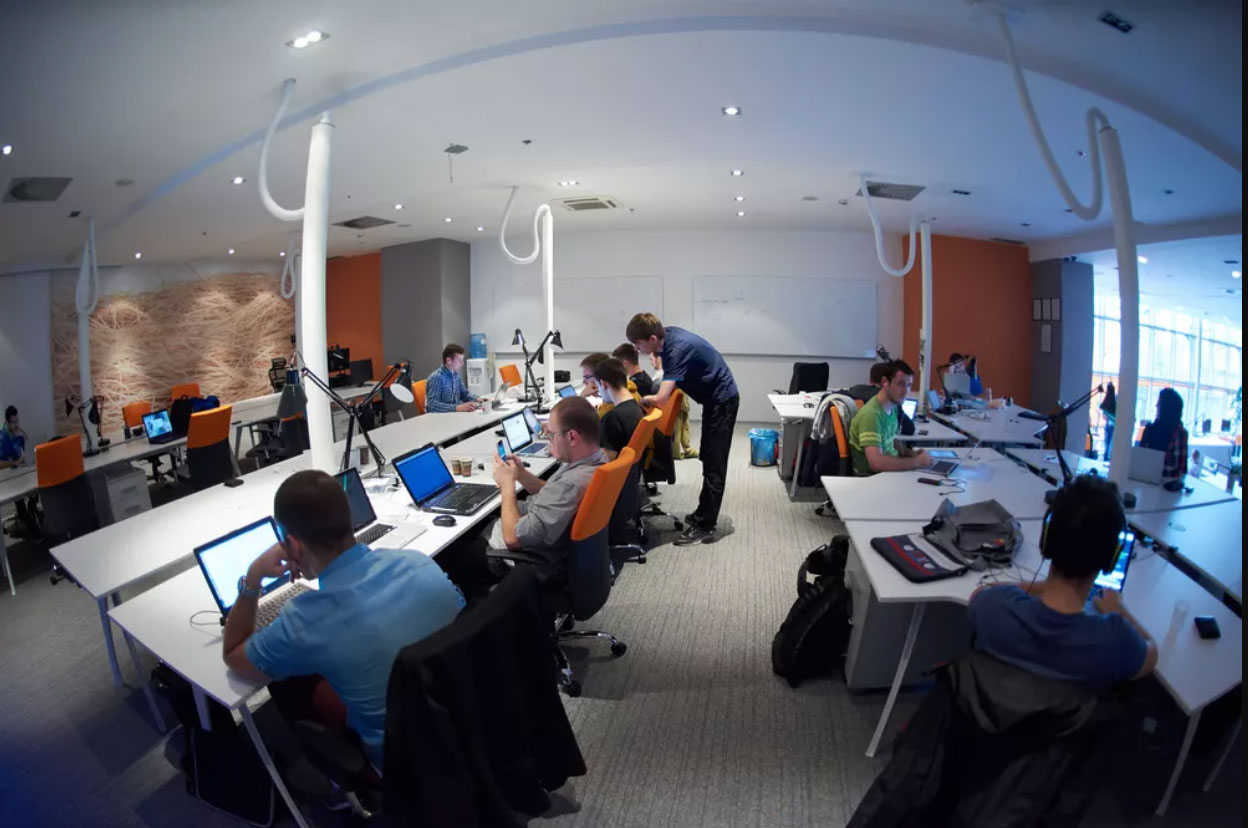
Nearshoring provides the benefits of offshoring but without the problems associated with it.The job market is one of the biggest casualties of the coronavirus pandemic, with shutdowns leading to staff reductions or businesses closing outright. However, the software developer market seems immune to the effects of Covid-19. Lockdowns encouraged more people to head to digital stores driving the strong demand for IT services. In turn, companies began to pivot to the online space to maintain their market share.
The Evans Data 2021 Worldwide Developer Population and Demographics Study reported that despite a shrinking global economy, the worldwide software developer population grew by 500,000 in 2020, a 2.4% growth rate given the circumstances. However, the demand for talent remains high. CodinGame’s latest developer survey reported that 61% of HR professionals reported that finding qualified developers present their biggest recruitment challenge.
Fortunately, the pandemic also showed the world that remote-based work is actually not such a bad idea. Both employers and employees were in unison that spending time at the office is no longer necessary as long as the job gets done. Amid the COVID-19 pandemic, staying home to work might even be more efficient and safer of course.
Outsourcing Remains A Great Source For Proven Talent

The pandemic also propelled the cost factor to the top of primary considerations in operations. The 2020 Deloitte Global Outsourcing Survey found that cost considerations remained at par with enabling speed to market, scaling faster, enhancing user experience, and achieving competitive advantage as the main drivers of outsourcing.
However, once the pandemic brought the global economy to its knees, companies were in scramble mode. Many had to choose between drastic cost-cutting or shutting down completely. Meanwhile, the fear of coronavirus changed the concept of remote work from an occasional luxury to a new normal necessity. These developments made companies revisit the practicality of outsourcing. When companies realized they needed to bolster their online presence, outsourcing provided readily available talent, especially top-tier software development personnel.
Many non-IT clients often start with a clear and well-developed idea of what software or application to create. But, they often have a limited grasp of what an ideal software engineering team consists of. In some cases, clients assume that a single software engineer will deliver the goods. In most cases, though, the job will require the combined efforts of specialists to get the specified task done on schedule and within budget.
Providers Can Help Assemble An Ideal Software Development Team
While cost is an important factor in determining the software development team’s composition, non-IT clients may find it difficult to make heads or tails of the project’s resource requirements. In contrast, a skilled outsourcing provider can better assess a client’s needs. They can help bridge the gap between what the client wants and what a development team can do. They can also help clients realize the budgetary impact of what they want to be accomplished.
After all, software development isn’t a single, freewheeling entity. By guiding the client along each stage of the development, they can better understand what an ideal software development team can do. The provider can help introduce the client to the benefits of deploying a well-structured unit with specific and complementary roles drawing on each member’s strengths instead of a one-size-fits-all specialist.
Instead of putting faith in a single engineer to hurdle all the challenges of software development, getting a team of experts in their respective fields can help cover all aspects of software development faster and more efficiently.
Different Nearshoring Options

Nearshoring options in software development can come in many forms, depending on the client’s requirements and methodology. Before agreeing to a deal, clients should go over with the developer team the scope of the work basics. Since this is being discussed the client should also take this opportunity to go over the contract and determine how the project should get billed.
Nothing can both bloat and delay a project and demoralize the team than miscommunication on the scope and the agreed-on methodology. This is where the advantages of nearshoring also come into play. With fewer cultural nuances to consider, there are lesser chances for misunderstanding.
For projects requiring a simple, no-frills development, a fixed contract based on a Waterfall methodology might work. More likely, clients would prefer to anticipate any iterations to the design and go with an Agile methodology. Of course, this will entail a more capital-intensive approach. For maintenance and update work for existing software, the time and material mode of service agreement might be more fitting.
To avoid any complications midway, make sure that all parties sign off on the agreed scope, methodology, contract, and schedule. Only when everybody’s onboard can the team even consider writing the first line of code.
Software Development Team Structure
Assembling a dedicated development team instead of assigning the entire work to a jack-of-all-trades developer is an example of applying strength by numbers. For this reason, outsourcing providers will need to discuss with clients the various roles that comprise the development team. This helps clients get a better grasp of each role and how important they are in achieving the desired results.
Frontend Developer

The software’s front end usually makes or breaks a software’s usability. The front-end developer is tasked with providing everything the end-user will need to operate the software. A smooth user experience requires that the frontend developer make sure that all buttons, text boxes, navigation devices, and displays are correctly showing on the screen and responding correctly. An added challenge for the frontend developer would be to ensure that all users receive a similar user experience regardless of the device or operating system used.
Backend Developer
Unlike the frontend, the backend deals with all the processes running inside the software invisible to the end-user. The backend developer makes sure that whatever instructions the end-user gives via the frontend, the application can process and deliver results. For this to happen, the backend developer needs to know the entire application’s architecture inside out. The software engineer assigned to this task needs to ensure all internal processes run, APIs and integrations work seamlessly, and the entire application remains stable and secure. In most cases, the backend developer ensures that the applications utilize the most efficient solution to solve complex app requirements.
Quality Assurance Engineer
With the front and back ends established, the quality assurance engineer is tasked with making sure both ends work and that they work with each other. The ability to spot your own errors is a rare feat in software development. Instead of relying on the developers to look out for bugs, dedicated QA specialists can hunt for bugs themselves. Also, QA engineers check the application’s performance, usability, and even appearance. They poke holes to see if security measures hold up, and test the program’s portability. In addition, quality assurance engineers make sure each identified bug and performance is documented for the rest of the team to learn from.
Quality Assurance Automation Engineer
This software development role is complementary to the QA engineer. Similar to stress testing products, QAA engineers develop automated scripts designed to simulate specific tasks performed by the software. They look out if the new features work as designed. However, they also check if previously running features or processes get affected by the newly installed items. In essence, the QAA engineer runs automated processes to try and weed out bugs before a user gets the chance to report them.
DevOps Engineer

The DevOps engineer takes the application and tests it against the real world. The role measures the software’s ability to withstand real-world scenarios and yet remain fast, secure, and accessible. DevOps engineers check the application if it scales along with a growing number of users. They monitor performance and help prevent overloading even as more users join in, making sure the app remains online. By ensuring that the software adjusts its capacity based on the current workload, the DevOps engineer keeps the operation cost-efficient. Otherwise, expect ROI targets to take a hit as the software turns resource-hungry when dealing with more users than it can handle.
Product Designer
The product designer is a member of the software development team that’s tasked with appearances. The role requires a good eye and a creative flair to design the application interface into a more intuitive layout. Apart from the superficial, the product design also takes note of how users respond to the interface and the controls. This lets them evaluate and make improvements to the layout. By aligning with the sales and marketing teams, the product designer can also determine the optimal placements for call-to-action buttons that push the eventual sale.
Project Manager

Similar to a conductor working on an orchestra, the project manager ensures that the entire software development team is working in sync. It’s the PM’s responsibility to keep the project running on schedule and on budget. In between, the project manager needs to motivate developers, identify risks to the project, monitor developments, maintain communication lines throughout the team, and keep track of the budget. As the bridge between the software development team and the client, the PM provides a distinct perspective on the project. Attention to detail is key to a successful project management gig. As such, stakeholders expect the PM to know the ins and outs of the project and provide the information.
Business Analyst
The business analyst provides a real-world check on the project during the software development phase. The role provides the project with the data needed to ensure the completed product addresses the needs of the market it earlier identified. At the same time, the business analyst also tracks if the product remains aligned with the business model it originally came with. Utilizing analytics and project data, the business analyst helps keep the project aligned with its objectives and provides the necessary information if a market shift requires a development shift as well.
Nearshoring Can Help Assemble A Software Development Team More Efficiently
Given the diversity required in assembling a competent software development team, securing an agency partner is a more efficient method to secure talent. The excitement and passion in developing a new application can easily evaporate. Recruiting isn’t as simple as it used to be, especially with the current demand outstripping supply.
Outsourcing becomes a more practical choice in a competitive and cost-conscious environment. A ready project team reduces the time-intensive and costly process of manpower pooling and recruitment.
If a previous experience with offshoring soured your interest in outsourcing, consider nearshoring before deciding to engage in direct hiring. Nearshore talent providesthe benefits of outsourcing while reducing the concerns of offshoring. It provides the cost savings of outsourcing while it eliminates the problems brought about by working in different time zones and reduces the need to travel long distances. At the same time, nearshoring reduces the miscommunication brought about by cultural or language differences.
Choosing a Software Development Partner

Getting a qualified and competent software development partner isn’t a matter of getting the best and most expensive talent available. It pays to get a better look at the quality of talent an outsourcing agency provides. For one, how do developers see the agency? Do they look at it as a favored business partner or a concerned mentor whose interests align with yours? Or, do they look at an agency as a necessary evil they need to deal with? A healthy, professional working relationship with its talent is often the first sign to look for when considering an outsourcing agency.
The quality of an agency’s hiring team often determines the quality of the agency. Especially with a very competitive market, it’s essential for clients to partner with agencies that have a grasp on not just hiring top talent, but retaining them as well. As such, savvy software development team handlers must be as agile as the developers they want in their roster. In fact, agencies that are capable of making quick but thoughtful hiring decisions are more apt to acquire top talents. This is especially true if the agency possesses the following attributes:
They Speed Up The Process
Top talents will never stay long in the market. Making a quick move by being upfront about the job details lets them decide faster, allowing both parties to move on to the next step or next offer. Successful agencies know they need to share upfront with candidates details about the position, salary, and benefits. This saves everybody time and establishes that the agency values the candidate’s time. At the same time, shorting the hiring process in a matter of days benefits both the agency and the candidate. Even rejections shouldn’t take a longer time.
They Look For Talent, Not Skills
Information technology is not a static industry. Programming languages are always evolving, and the hottest programming language today may not be in demand in a few weeks or months. Talent evaluators should know better than hiring developers who specialize in specific languages. The better prospects out there are developers who can pick up a new language given enough time to learn. Talent-based evaluations can help match clients better with developers, especially if both have the same drive and approach to problem-solving.
They Provide A Challenge, Not Just A Job Opening
As the development job market favors supply (there is more demand), prospects aren’t looking for jobs as much as challenges. They know getting a job is easy, but when faced with a multitude of offers, developers often grab at the chance to face a worthwhile challenge. Instead of delivering a standard pitch offering the position, the best agencies tell a story on what the job entails that the developer might find interesting.
They Respect the Candidate’s Efforts
In addition, compensating veteran developers for additional tests or interviews shows the agency knows their full value. On the off chance that candidates change their minds on a previous offer, developers might likely consider the agencies that valued their experience. Conversely, subjecting developers to a battery of tests and interviews only to reject them will leave a bitter taste in their mouths.
They Talk Shop With Developers Using Their Own Language
Instead of asking developers about abstract ideals, getting them to talk about solutions to real-world software development issues might provide better insight into how they work. Simulating a work environment and asking developers their suggested approaches gives an opportunity to talk shop with candidates. This also places them in a more comfortable environment that talks their shop language. With the right leading question, candidates can be made comfortable enough to let them talk more freely about their expert opinions.
Get A Nearshoring Agency That Can Help You

There is a growing demand for software development services, especially in Europe. With the world’s companies shifting to the digital landscape, the need for skilled software developers is increasing in the region as well. The current economic climate and a company’s long-term objectives often do not require the need to hire full team development teams. At the same time, many companies do not possess the necessary skillset or the job language to effectively evaluate and hire the talent they need.
Nearshoring offers a solution that balances the need to deliver results while remaining focused on the bottom line. It offers better results than offshoring, which can sometimes run into complications due to cultural, geographic, and chronological disparities.
Growin is one such modern nearshoring company. It aims to provide backend support to companies that need help in creating a bigger digital footprint. The company possesses the expertise and experience in screening, hiring, and maintaining a pool of ready talent to help with the needs of the digital front.
As a team, we prefer hearing the words “great work” and “good job!” coming from partners and clients. Thankfully, some of our most successful partnerships get published on industry websites. This includes The Manifest, a business website that publishes data-driven benchmarks, how-to guides, and agency shortlists. In Manifest’s Top 20 Software Development companies in Portugal, Growin is comfortably occupying the top ninth spot. Meanwhile, data-driven field website Clutch gave Growin a perfect 5-star rating. Clutch, which helps companies make business-buying decisions, takes their overall rating from client reviews and feedback.
To learn more about how Growin can help deliver your business objectives in a more efficient and cost-effective manner, contact us.


